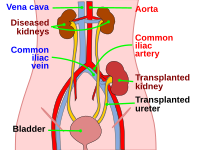
Photo from wikipedia
Background Double filtration plasmapheresis (DFPP) was initially used to facilitate the conduction of ABO-incompatible renal transplantation. The applicability of DFPP has recently expanded to cover the removal of various antibodies… Click to show full abstract
Background Double filtration plasmapheresis (DFPP) was initially used to facilitate the conduction of ABO-incompatible renal transplantation. The applicability of DFPP has recently expanded to cover the removal of various antibodies in adults with immune-mediated diseases. However, DFPP is seldom used in children, with few reports addressing its efficacy and safety in this population. This study aimed to explore the efficacy and adverse effects of DFPP for pediatric patients with renal indications. Methods Children who received DFPP between December 2017 and December 2020 at Tongji Hospital were retrospectively studied, and sub-grouped for analysis according to the types of disease. All children received 3 to 6 DFPP sessions within 2 to 3 weeks, and were assessed for clinical outcomes according to glomerular filtration rate, proteinuria and extra-renal symptoms. Pre- and post-DFPP plasma were collected to measure the levels of pathogenic autoantibodies, immunoglobulins, fibrinogen, albumin, calcium, etc. In-hospital complications were also recorded. Results Totally there were 10 children receiving 44 sessions of DFPP, including 2 males and 8 females, with a median age of 11.2 years old (5–13 years) and a median weight of 42.1 kg (20–59 kg). Five patients were treated for systemic lupus erythematosus (SLE), three patients for antineutrophil cytoplasmic antibody (ANCA)-associated vasculitis (AAV), one for C3 glomerulopathy and one for ABO-incompatible renal transplantation. Plasma autoantibodies decreased substantially by 93% and 89% in those with SLE and AAV after the last session, respectively. Complete or partial responses were achieved in 80%, 33.3%, 100% and 100% of patients with SLE, AAV, C3 glomerulopathy, and ABO-incompatible renal transplantation, respectively. The proportion of cumulative IgG, fibrinogen, and albumin removal at the end of the last sessions were 58.8%, 67.69%, and 14.05% respectively. The removal of calcium, potassium and creatinine were not statistically significant. A few episodes (4.55%) of hypotension were observed when fresh frozen plasma was used as the replacement fluid, and no bleeding nor severe anaphylaxis was noted. Conclusions The efficacy and safety of DFPP treatment in children with SLE, AAV, C3 glomerulopathy and ABO-incompatible renal transplantation were described in the present study. DFPP is proven to be a safe apheresis method for children weighing more than 20 kg.
Journal Title: Translational Pediatrics
Year Published: 2023
Link to full text (if available)
Share on Social Media: Sign Up to like & get
recommendations!